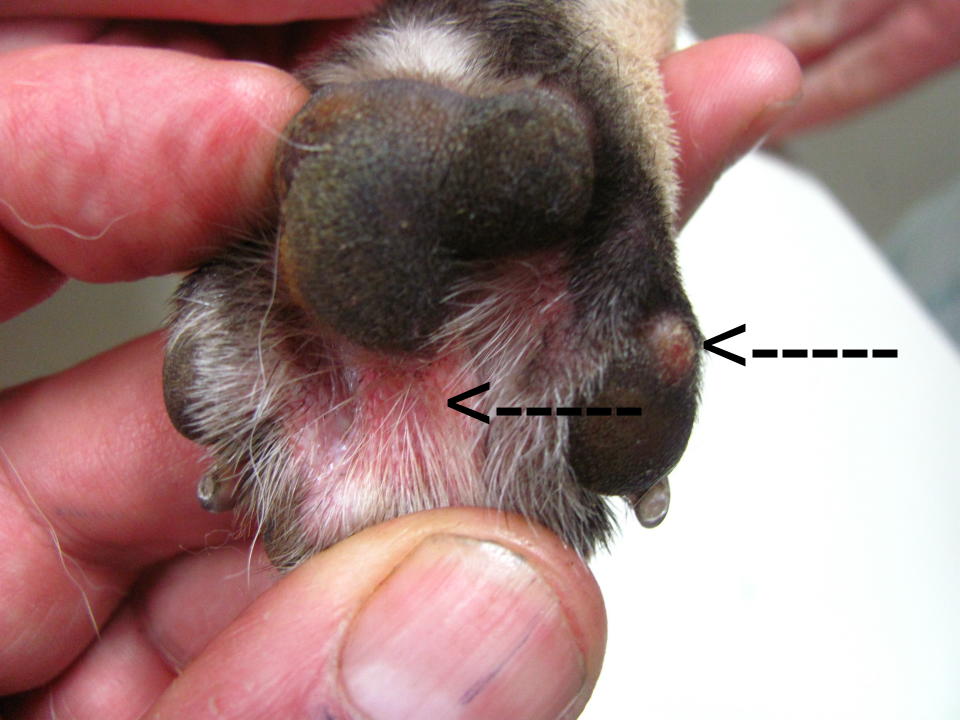Understanding Your Dog's Pink Paw Pads
Have you ever noticed the soft, pink pads on your dog's paws? These seemingly simple structures play a vital role in your canine companion's comfort and mobility. While we often take them for granted, understanding the nuances of paw pad health, including pigmentation, is essential for responsible dog ownership.
A dog's paw pads are remarkable feats of natural engineering. They provide cushioning against rough terrain, insulation against extreme temperatures, and traction for running and playing. The color of a dog's paw pads can vary, often influenced by genetics and breed. Pink paw pads are a common occurrence, especially in dogs with lighter coats. But what does the pink pigmentation signify, and are there any special considerations for dogs with pink paw pads?
The pigmentation in a dog's paw pads comes from melanin, the same pigment responsible for skin and hair color. Dogs with pink paw pads typically have less melanin in these areas. While pink paw pad color is generally considered normal, it's crucial to be aware of potential sensitivities that may arise. Just as fair-skinned humans are more susceptible to sunburn, dogs with less pigmented paw pads can be more prone to irritation and injury from hot surfaces, rough terrain, and certain chemicals.
Caring for a dog with pink paw pads involves paying extra attention to their paws and protecting them from potential hazards. Regular inspections for cuts, abrasions, or foreign objects are essential. During walks, be mindful of hot pavement, which can cause burns. In winter, protect your dog's paws from ice, snow, and de-icing chemicals, which can cause irritation and cracking. Using paw balm can help moisturize and protect the pads from environmental stressors.
Beyond environmental factors, certain medical conditions can also affect paw pad health. Allergies, infections, and autoimmune diseases can sometimes manifest in paw pad changes, including redness, swelling, and itching. If you notice any unusual changes in your dog's paw pads, it's essential to consult a veterinarian for diagnosis and treatment.
One simple trick to protect light-colored paw pads is to apply a thin layer of petroleum jelly before walks during extreme weather. However, avoid using scented or flavored balms as these can attract your dog to lick their paws, potentially ingesting harmful chemicals.
Advantages and Disadvantages of Pink Pads
| Advantages | Disadvantages |
|---|---|
| Often associated with lighter coat colors, which can be aesthetically pleasing to some owners. | Increased susceptibility to sunburn and burns from hot surfaces. |
| Easier to spot foreign objects or injuries due to the lighter color. | More prone to irritation from rough terrain, ice, snow, and chemicals. |
Frequently Asked Questions about Pink Paw Pads
1. Are pink paw pads a sign of a health problem? Not usually. Pink pads are often simply a result of less pigmentation.
2. Can pink paw pads get sunburned? Yes, they are more susceptible to sunburn.
3. How can I protect my dog's pink paw pads in winter? Use dog booties or paw balm to protect against cold and chemicals.
4. What should I do if my dog's paw pads are cracked or bleeding? Consult a veterinarian.
5. Are there specific breeds more prone to pink paw pads? Yes, breeds with lighter coats are more likely to have pink pads.
6. Can paw pad color change over time? While less common, pigmentation can sometimes change slightly with age or due to certain medical conditions.
7. Is it normal for pink paw pads to be slightly rough? Some texture is normal, but excessive roughness or cracking can be a sign of a problem.
8. Can I use human sunscreen on my dog's paw pads? No, use only products specifically formulated for dogs.
In conclusion, understanding the unique characteristics of your dog's pink paw pads is crucial for their overall well-being. While pink pads are often a harmless cosmetic trait, they can indicate increased sensitivity to certain environmental factors. By implementing preventative measures like using paw balm, avoiding hot surfaces, and regularly checking for injuries, you can help ensure your dog's paws remain healthy and pain-free. Remember, healthy paws mean a happy and active dog. Taking the time to care for your canine companion's paw pads will undoubtedly strengthen your bond and contribute to their long-term health and happiness. So, next time you're petting your furry friend, take a moment to appreciate those remarkable pink pads and give them the extra care they deserve.
Decoding the viral phenomenon the gray cat stare meme
Conquer carpet chaos your guide to carpet cleaner rentals in hamilton
The silent struggle when your vacuum pump fails










:max_bytes(150000):strip_icc()/GettyImages-1144580161-e70991a2415d46608aeb91e43acc3ad5.jpg)



